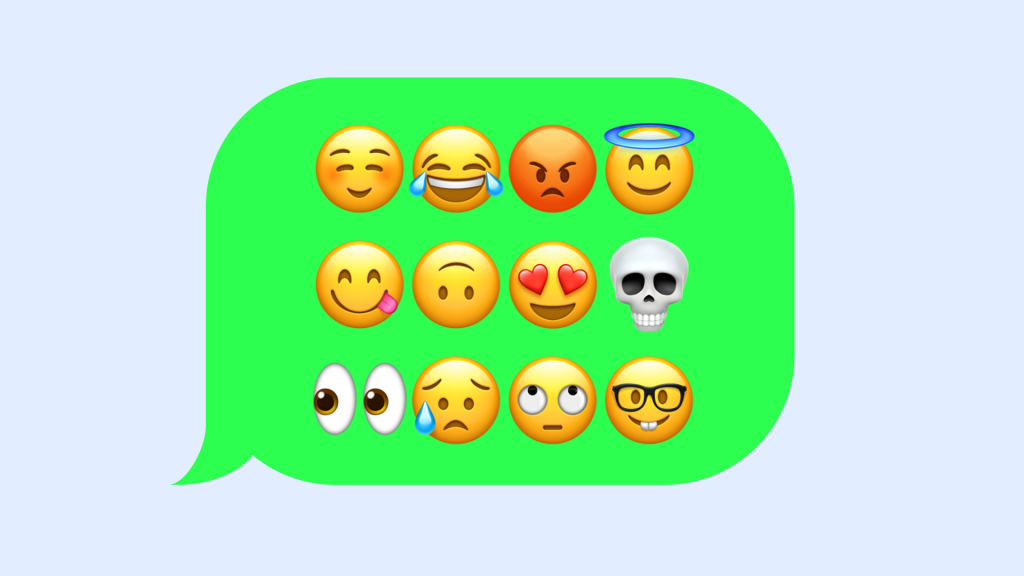Where Do Our Favorite Emoji Come From?

While some people might view emoji as silly little characters, that’s not how we see it. There’s a sophisticated linguistic system in the way people use emoji, and that’s something we take very seriously at Dictionary.com. Emoji are a very real way people are communicating, and who better to think deeply about emoji than a reference source that investigates meaning?
In this piece, we’ll take a step back and look at some broader questions about emoji. Where did emoji come from in the first place? Who decides what new emoji appear on all our devices? How does the process of creating new emoji compare to the process of getting a new word into a dictionary?
Where did emoji come from?
The story of emoji begins in Japan.
The word emoji, for that matter, is Japanese: e means “picture” and -moji means “character.” This term has been floating around since as early as the 1970s, before the first emoji set was introduced, but it was in art history and design contexts and did not carry the same digital connotations it carries today.
The first emoji set was created in 1999 by artist Shigetaka Kurita for the phone company NTT DOCOMO. Screen real estate was valuable, and they wanted a way to express concepts in a tiny amount of space. Ideograms, or written symbols that represent ideas or objects directly, would do the trick.
So, Kurita designed the first emoji set, a group of 176 12×12 pixel images. These 176 designs have been powerfully influential on the development of the emoji that we use today. In this initial set, there are a handful of emoji related to sending and receiving messages, emails, calls … and because it was 1999, faxes.
Of the initial 176 emoji, only five are faces expressing human emotion.
Kurita’s designs were so popular and useful that other Japanese mobile phone companies soon followed with their own emoji. At this time there was no standardization, and so emoji looked different across mobile carriers, which was a communication barrier. Additionally, it was difficult, if not impossible, for people outside Japan to use emoji. But, this all changed in 2010 when emoji moved over to Unicode.
What is Unicode, and what does it have to do with emoji?
Unicode is the technical standard that supports emoji, and the Unicode Consortium is the nonprofit organization that maintains the Unicode standard. They have a lofty mission: “To enable everybody, speaking every language on the Earth, to be able to use their language on computers and smartphones.”
The move to Unicode allowed for people to more easily use emoji worldwide across various devices. Different platforms like Apple, Google, and Samsung have their own proprietary emoji designs, but the Unicode Consortium offers guidance on how each emoji should look.
How do new emoji get created?
Today, the Unicode Consortium is the group that decides what new emoji will appear on all our devices. They review and vote on new emoji proposals submitted by people around the world.
One popular proposal type is various breeds of dog beyond a few existing dog emoji (🐶 🐕 🐩). However, these proposals have not been successful historically because the committee believes that a specific type of dog emoji can (and is) used as a stand-in for all types of dog. If a concept at large is already representable with the current emoji offerings, it is very unlikely to become a Unicode codepoint.
About 60–100 new characters are approved by Unicode each year, but the amount varies. This is because it takes a lot of work to support each individual emoji, and major vendors like Google, Apple, and X are willing to support only a limited amount of new emoji per year.
Anyone can submit a proposal for a new emoji. All you have to do is compile evidence for anticipated usage of the proposed emoji.
New words vs. new emoji
The process of adding new words to dictionaries can be seen as somewhat the opposite of the process of getting a new emoji approved. Lexicographers think about actual usage, whereas the Unicode Consortium thinks more about anticipated usage.
In modern lexicography, we see how a term is actually being used, and that informs whether or not we add it to Dictionary.com, and how we define it if we do. Lexicographers are not gatekeepers. Rather, we’re observers and recorders of language, taking a particular interest in how meaning changes and evolves over time.
The Unicode Consortium, on the other hand, are very much gatekeepers. Only a small amount of emoji can be approved each year, and these decisions must be made before anyone can know for certain if people will actually use a new emoji. The Unicode Consortium asks questions to get at how a proposed emoji might be used: Is there evidence of interest? Is it frequently requested? Is it polysemous? Is it already representable?
That last question is something lexicographers would never ask. We don’t exclude words from our dictionary because there are already many ways to say the same thing. We wouldn’t say, “We can’t add swipe right to Dictionary.com because there are already a bunch of words that mean you like or approve of something.”
While the process of emoji birth differs from that of adding new words to dictionaries, for both of these, meaning is the prime concern.